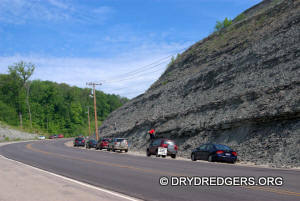
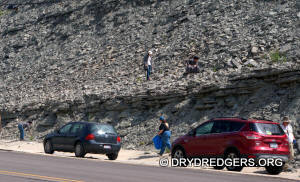
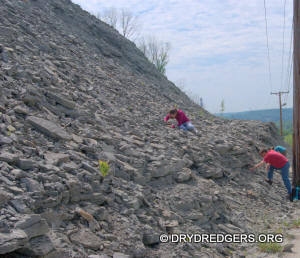
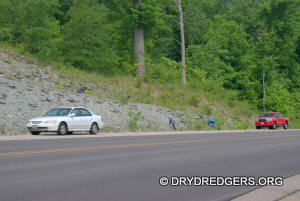
Photos and words by Bill Heimbrock
The Dry Dredgers had a great Memorial Day weekend field trip to a new road cut in Indiana not far from Cincinnati. The weather was so nice, we could have fired up the grill. As happens with new road cuts, this site became the focus of intense study by the University of Cincinnati Department of Geology. Once all the measurements were taken by UC, theses written and papers published, we were given the green light to "dredge the Late Ordovician sea floor", surface collecting fossil specimens of brachiopods, bryozoans, trilobites, crinoids, mollusks and other fossils more than 440 million years old for our personal collections and amateur paleontology studies.
After the Dry Dredgers meeting the night before the field trip, Dr. Carlton Brett of the UC Geology Dept. gave us an excellent slide show tour of the layers exposed on this site. For us, this would be a learning experience in cycle stratigraphy. With these new tools and and a new site, we were given the fuel to find new fossils.
Fossils Found that Day: Fairview Formation
Crinoids
We found a lot of crinoid stems but NO calyxes! (crinoid crowns). The most
interesting stem we found was this
coiled holdfast from what is probably an
Iocrinus subcrassus.
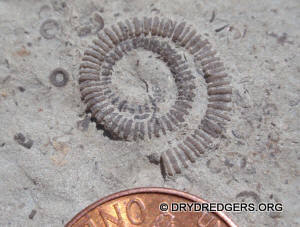
Here's a really nice slab literally loaded with stems of
Iocrinus subcrassus.
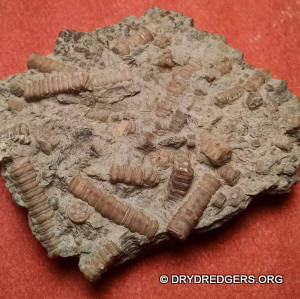
Photo complements of Steve McCabe.
Trilobites
Flexicalymene sp.
We came close to finding a whole
Flexicalymene meeki trilobite. Here are a couple of prone
specimens that are less than complete.
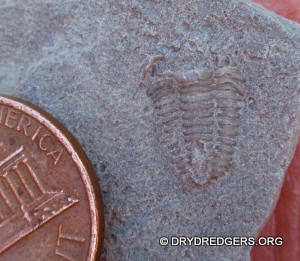
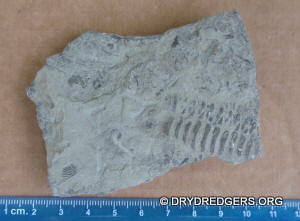
People found the glabellas (heads) of Flexicalymene
trilobites. They are very distinct and you know when you find one.
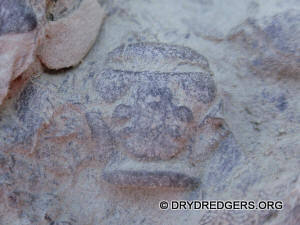
Isotelus sp.
No whole Isotelus sp. trilobites were found, but whole Isotelus sp. are rarely found anywhere. In the Fairview Formation, you can find lots and lots of fragments of Isotelus trilobites.
Here's a really big hypostome (mouth plate) of an Isotelus trilobite on a rock
surface. The U.S. Cent is for scale. This was a large trilobite!
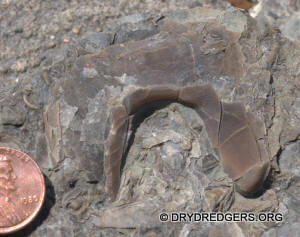
We also found some very large thorax segments from Isotelus.
The one below is one thorax segment from the axial
lobe and one of the two pleural lobes.
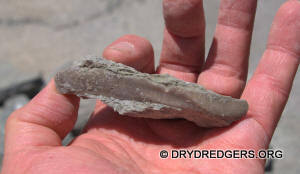
The rocks had lots of brown colored fragments that were clearly
Isotelus but not clear what part of the exoskeleton it was. The
one below has a nice Cephalopod fragment next to it. Do you see it?
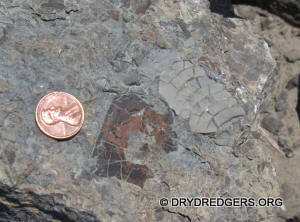
Cephalopods (Fairview Formation)
Straight-shelled nautiloid cephalopods were pretty common on this site. These
first two pictures are of ones that are preserved as internal molds. You can see
the individual chambers that were once filled with mud. This mud infill is what
is remains in fossil form.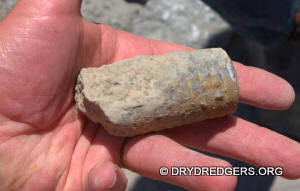
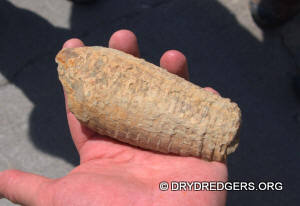
In other cases, the nautiloid cephalopod is preserved in rock that was
originally the mud and shell debris in which the animal was burried. Sometimes
water fills the cavity in the rock where the cephalopod shell once existed and
deposits calcite. 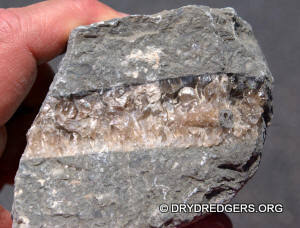
The calcite can fill the individual chambers giving the cephalopod fossil a nice
brown color to each chamber.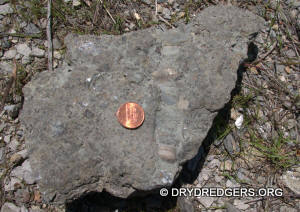
Other times, the cephalopod is preserved by the bryozoans that encust it.
In the example below, the cephalopod was encrusted with the bryozoan,
Spatiopora sp.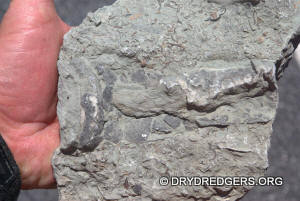
Bryozoans (Fairview Formation)
Anybody who as fossil hunted in the Fairview Formation knows it is loaded with bryozoans - fat ones, skinny ones, bryos that grow on rocks. Sturdy ones, fragile ones, even ones with chicken skin. Okay, sound familiar?
We saw lots of large bulky Trepostomate bryozoans. These bryozoans grow into large fan shapes, fat and thin. (next 5 photos)
One particular bryozoan that is easy to identify by genus is
Constellaria florida. It has a "chicken skin" surface
in which each of the "goose bumps" or monticules are star shaped. (next 2 pics)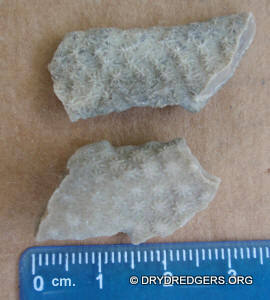
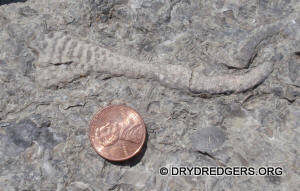
Some types of bryozoans we saw that day grow on rocks or shells. The one shown
below is a lovely fenestrate
bryozoan.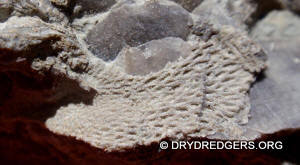
Another bryozoan with "chicken skin" is pictured below (next 2 pics). It is
probably Parvohallopora ramosa.
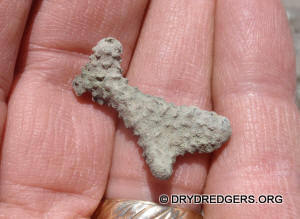
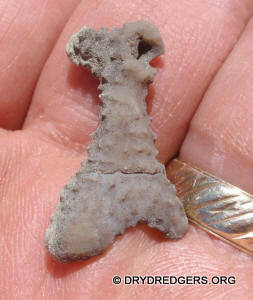
Brachiopods from the Fairview Formation
Cincinnetina sp.
In one layer, the Cincinnetina sp. brachiopods were colored red. This makes it a
distinct marker bed for knowing where you are in the strata.
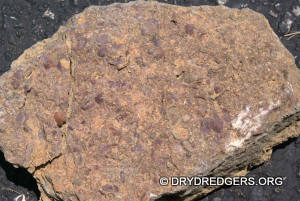
Rafinesquina sp. were also found to be colored red in at least one layer.
In a higher layer of the Fairview Formation, we found examples of the species
Rafinesquina fracta.

On some of these "articulate" Rafinesquina
brachiopods, we found attached inarticulate brachiopods. The one below is
Petrocrania scabiosa.
Notice how the Petrocrania imitated the plications (lines) of the Rafinesquina
on which it was attached. This is a pretty interesting specimen for that reason.
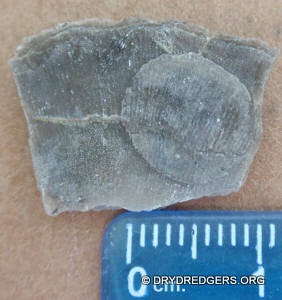
Zygospira sp.
Gastropods (Fairview Formation)
Cyclonema humerosum
Pelecypods (Fairview Formation)
Ambonychia sp.
Ichnofossils (Trace Fossils)
Fossils Found that Day: Middle and Upper Kope Formations
In the lower portions of the road cut we fossil hunted in the middle and upper Kope (Latonia) formation.
At the very bottom of the road cut in the Kope were nodules weathering to the surface which had originally hardened during the Late Ordovician period. In some cases, animals attached themselves to these nodules (such as bryozoans and crinoids). In other cases, the nodule has a fossil or pyrite-filled burrow inside of it. (next 5 pictures)
Cincinnetina multisecta
(formerly Onniella/Dalmanella multisecta)
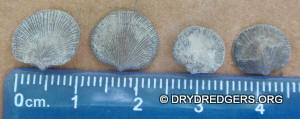
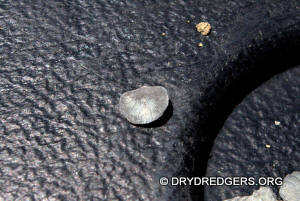
Crinoid stems were found in abundance in the middle and upper Kope but as was true for the Fairview Formation, no calyxes (crowns) were found.
This stem was particularly interesting because it had bumps
running in rows down a round stem. 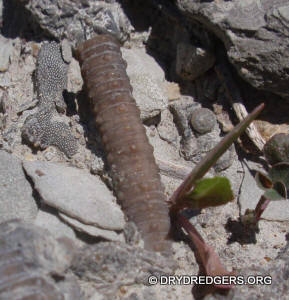
But examination of the side of the above interesting crinoid
and nearby stems, revealed that it is
Iocrinus subcrassus.(below)
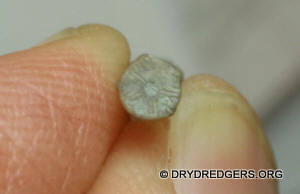
In one layer of the Kope, thousands of small fragments of the
large trilobite Isotelus sp. were found.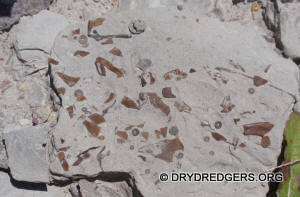
One person found a really weathered rock of shell hash that had an imprint of a
Flexicalymene pygidium on it. (Next 2 pictures.)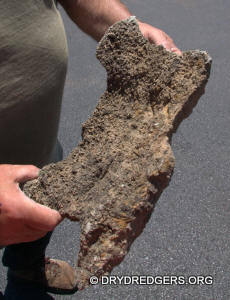
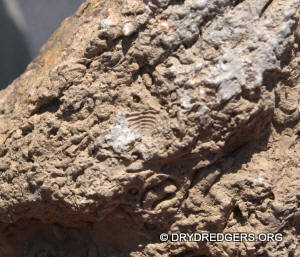
We'll that's all we found as far as I know. We were kind of spread out on the site, so if anyone else found anything interesting, please email me the pictures to billheim@cinci.rr.com and I'll include them in this report. Thanks.
That's all for this field trip.
Now let's see our June road trip to Penn Dixie in New York and Ridgemount Quarry in Ontario.
Back to the Field Trip Index Page
Return to Dry Dredgers Home Page
The Dry Dredgers and individual contributors reserve the
rights to all information, images, and content presented here. Permission to
reproduce in any fashion, must be requested in writing to admin@drydredgers.org.
www.drydredgers.org is designed and maintained by Bill Heimbrock.